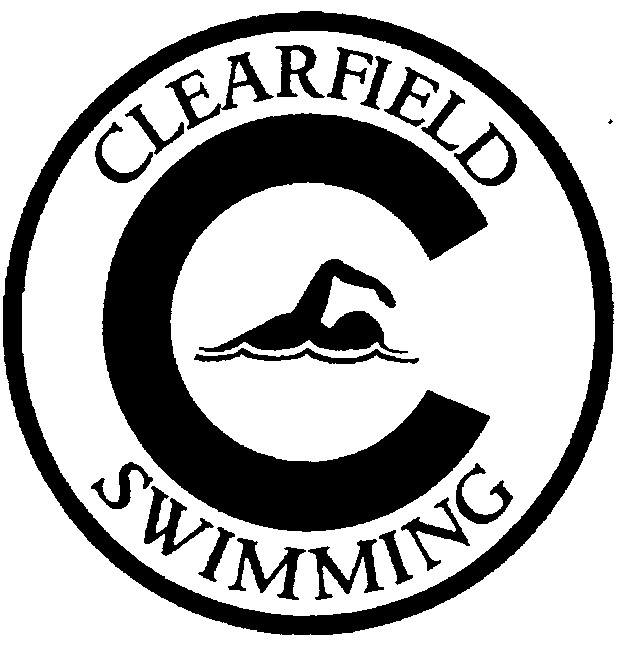






www.clearfieldswimming.org, is sponsored by the Clearfield Aquatic Club
and is neither affiliated with nor endorsed by the Clearfield Area School District ,
The Clearfield YMCA nor the Clearfield Community Pool Association
and is neither affiliated with nor endorsed by the Clearfield Area School District ,
The Clearfield YMCA nor the Clearfield Community Pool Association
12-19-14
clearfieldfootball.org photo
Understanding Diving -
A diver's most important asset is spatial orientation and balance.
A diver needs to know where he is during every part of his dive. He/she
also needs to be in excellent physical condition in order to maneuver his
body in the air so as to give the impression of effortlessness.
All dives are classified according to their direction in relationship to
the board,and as thus divided into 5 categories:
1. Forward Dives; 2. Backward Dives; 3. Reverse Dives (walk forward, dive back toward the board); 4. Inward Dives (stand backward on the end of the board and dive
toward the board); and 5. Twist Dives.
*Please note the word "dive" is a catch-all term sometimes used to describe anything done off the board - head or feet first - but the strict meaning of the word denotes a head first entry into the water.
A diver's "list" of dives for a meet must contain dives from 4 of the 5 groups.
The first dive is called the voluntary dive. All other dives are optional dives. A high school dual meet list would consist of one voluntary dive and five optionals from at least four groups.A championship list would be all five voluntary dives and six optionals.
Dives also must be done (and listed) in one of four positions:
Tuck - bend at knee and waist
Pike - bend the waist only
Straight - no bends
Free - combination of any positions
Divers also have the option of using a standing or running takeoff.
What to watch for - when the competitor is ready, the dive is announced
and a signal is given by the referee. After the dive, and at another signal from
the referee, the judges immediately announce their scores.
A dive is judged on a l0 point scale: the smallest division being half a
point. Judges mark the dive so in their opinion that scoring falls into the
following broad divisions:
A diver's most important asset is spatial orientation and balance.
A diver needs to know where he is during every part of his dive. He/she
also needs to be in excellent physical condition in order to maneuver his
body in the air so as to give the impression of effortlessness.
All dives are classified according to their direction in relationship to
the board,and as thus divided into 5 categories:
1. Forward Dives; 2. Backward Dives; 3. Reverse Dives (walk forward, dive back toward the board); 4. Inward Dives (stand backward on the end of the board and dive
toward the board); and 5. Twist Dives.
*Please note the word "dive" is a catch-all term sometimes used to describe anything done off the board - head or feet first - but the strict meaning of the word denotes a head first entry into the water.
A diver's "list" of dives for a meet must contain dives from 4 of the 5 groups.
The first dive is called the voluntary dive. All other dives are optional dives. A high school dual meet list would consist of one voluntary dive and five optionals from at least four groups.A championship list would be all five voluntary dives and six optionals.
Dives also must be done (and listed) in one of four positions:
Tuck - bend at knee and waist
Pike - bend the waist only
Straight - no bends
Free - combination of any positions
Divers also have the option of using a standing or running takeoff.
What to watch for - when the competitor is ready, the dive is announced
and a signal is given by the referee. After the dive, and at another signal from
the referee, the judges immediately announce their scores.
A dive is judged on a l0 point scale: the smallest division being half a
point. Judges mark the dive so in their opinion that scoring falls into the
following broad divisions:
. . . Clearfield PA
clearfieldswimming.org
Clearfield Area High School . . .
Back to -
Competitive Swimming & Diving Explained -
Understanding Swimming :
Swimming is one of the most demanding,both physically and mentally,of all
sports. Most successful swimmers train two-a-day workouts, eleven months a year.
There are four strokes used in competitive swimming: butterfly, backstroke, breaststroke and freestyle. In addition, individual medleys ( made up of all four strokes ), relays and springboard diving are included in the meet programs.
In all races,with the exception of the backstroke, the swimmer starts
facing the pool. On the command "Take Your Mark", the starting position is
assumed. The starter will start the race only when all swimmers are motionless.
In the backstroke events all entrants line up in the pool facing the starting blocks.
The starter begins the race with a pistol shot or an electronic device. Any
swimmer charged with a false start is disqualified and cannot swim the event.
Backstroke: Swimmers push-off on their backs and continue swimming on their backs throughout the race. The touch on turns may be with any part of the body,
but the shoulders may not turn over beyond the vertical before the swimmer
touches the wall.
Breaststroke: The body shall be kept perfectly on the breast and both
shoulders shall be in line with the water surface. All arm and Ieg movements
must be simultaneous, in the same horizontal plane, and without alternating
movements. Part of the head must break the water level, each stroke , except at
the start and on turns where one pull and one kick may be done while wholly
submerged. At the turns and at the finish of the race the touch must be made with
both hands simultaneously.
Butterfly: Both arms recover together over the surface of the water and
are pulled backwards simultaneously while the body is kept on the breast with
the shoulders on the same horizontal plane. All up and down movements of the
legs and feet must be kept simultaneous with no alternating movements. No
breaststroke or scissor kicking movements are permitted. As in breaststroke,
both hands must touch simultaneously on the turns and at the finish of the race.
Individual Medley: The swimmer swims the prescribed distance as follows:
First one-fourth: Butterfly; Second one-fourth: Backstroke;
Third one-fourth: Breaststroke; Last one-fourth: Freestyle.
Each phase of the race must adhere to the rules governing that particular stroke.
Relays: Two types of relays are swum. The medley is swum with
four swimmers, each swimming a different stroke in the following order:
backstroke, breaststroke, butterfly and freestyle. In the freestyle relays,
each swimmer continuously swims one-fourth of the prescribed distance.
The lead-off person starts with a shot or electronic sound. Each succeeding
swimmer may be in motion, but must still have contact with the front edge of
the starting block when the preceding swimmer finishes.
Scoring: When scoring a high school dual meet with 6 lanes points are awarded
as follows: Relays -
No points are awarded for 4th through 6th.
One team may only place or score points with two relays; you cannot place1st,2nd and 3rd.
In all other events, the point structure is:
Swimming is one of the most demanding,both physically and mentally,of all
sports. Most successful swimmers train two-a-day workouts, eleven months a year.
There are four strokes used in competitive swimming: butterfly, backstroke, breaststroke and freestyle. In addition, individual medleys ( made up of all four strokes ), relays and springboard diving are included in the meet programs.
In all races,with the exception of the backstroke, the swimmer starts
facing the pool. On the command "Take Your Mark", the starting position is
assumed. The starter will start the race only when all swimmers are motionless.
In the backstroke events all entrants line up in the pool facing the starting blocks.
The starter begins the race with a pistol shot or an electronic device. Any
swimmer charged with a false start is disqualified and cannot swim the event.
Backstroke: Swimmers push-off on their backs and continue swimming on their backs throughout the race. The touch on turns may be with any part of the body,
but the shoulders may not turn over beyond the vertical before the swimmer
touches the wall.
Breaststroke: The body shall be kept perfectly on the breast and both
shoulders shall be in line with the water surface. All arm and Ieg movements
must be simultaneous, in the same horizontal plane, and without alternating
movements. Part of the head must break the water level, each stroke , except at
the start and on turns where one pull and one kick may be done while wholly
submerged. At the turns and at the finish of the race the touch must be made with
both hands simultaneously.
Butterfly: Both arms recover together over the surface of the water and
are pulled backwards simultaneously while the body is kept on the breast with
the shoulders on the same horizontal plane. All up and down movements of the
legs and feet must be kept simultaneous with no alternating movements. No
breaststroke or scissor kicking movements are permitted. As in breaststroke,
both hands must touch simultaneously on the turns and at the finish of the race.
Individual Medley: The swimmer swims the prescribed distance as follows:
First one-fourth: Butterfly; Second one-fourth: Backstroke;
Third one-fourth: Breaststroke; Last one-fourth: Freestyle.
Each phase of the race must adhere to the rules governing that particular stroke.
Relays: Two types of relays are swum. The medley is swum with
four swimmers, each swimming a different stroke in the following order:
backstroke, breaststroke, butterfly and freestyle. In the freestyle relays,
each swimmer continuously swims one-fourth of the prescribed distance.
The lead-off person starts with a shot or electronic sound. Each succeeding
swimmer may be in motion, but must still have contact with the front edge of
the starting block when the preceding swimmer finishes.
Scoring: When scoring a high school dual meet with 6 lanes points are awarded
as follows: Relays -
No points are awarded for 4th through 6th.
One team may only place or score points with two relays; you cannot place1st,2nd and 3rd.
In all other events, the point structure is:
The points considered are the run, the takeoff, the technique and grace
of the dive during the passage through the air and the entry into the water. The
detailed requirements are set out in the PIAA handbook though clearly these
are only a guide for the judges' technical appreciation and judgment.
Each permitted dive is listed in the P.I.A.A. handbook according to its
difficulty and is given a "degree of difficulty" ranging from 1.2 for the easiest
dive to 3.0 for some of the most complicated somersault or twisting dives.
To obtain the final score for a dive the following procedure is used:
When the judges display their scores the scores are added together and this
total is multiplied by the difficulty rating to obtain the final score.
of the dive during the passage through the air and the entry into the water. The
detailed requirements are set out in the PIAA handbook though clearly these
are only a guide for the judges' technical appreciation and judgment.
Each permitted dive is listed in the P.I.A.A. handbook according to its
difficulty and is given a "degree of difficulty" ranging from 1.2 for the easiest
dive to 3.0 for some of the most complicated somersault or twisting dives.
To obtain the final score for a dive the following procedure is used:
When the judges display their scores the scores are added together and this
total is multiplied by the difficulty rating to obtain the final score.
Completely Failed -
Unsatisfactory -
Deficient -
Satisfactory -
Good -
Excellent -
Exceplional -
Unsatisfactory -
Deficient -
Satisfactory -
Good -
Excellent -
Exceplional -
0 points
1/2 to 2
2-1/2 to 4
4-1/2 to to 5-1/2
6 to 7
7-1/2 to 8-1/2
9 to l0
1/2 to 2
2-1/2 to 4
4-1/2 to to 5-1/2
6 to 7
7-1/2 to 8-1/2
9 to l0
Example:
1 m. Springboard , reverse 1-1/2 somersault in pike position (#303), difficulty 2.5 .
Judges Awards: 7 , 7-1/2 , 8.
Add the scores together ( 7 + 7.5 + 8 = 22.5 ) X Difficulty ( 2.5 )
22.5 x 2.5 = 56.25 Final Score
lf two or more divers tie with the same score, a tie is declared.
1 m. Springboard , reverse 1-1/2 somersault in pike position (#303), difficulty 2.5 .
Judges Awards: 7 , 7-1/2 , 8.
Add the scores together ( 7 + 7.5 + 8 = 22.5 ) X Difficulty ( 2.5 )
22.5 x 2.5 = 56.25 Final Score
lf two or more divers tie with the same score, a tie is declared.
We hope this brief overview helps you understand and enjoy
CLEARFIELD BISON SWIMMING & DIVING !
Back to -
Competitive Swimming & Diving Explained -
8 points
4
2
4
2
6 Points
4
3
2
1
0
4
3
2
1
0
1st Place -
2nd -
3rd -
2nd -
3rd -
1st Place -
2nd -
3rd -
4th -
5th -
6th -
2nd -
3rd -
4th -
5th -
6th -
Print Friendly Version





